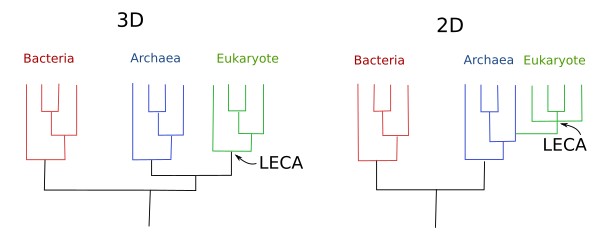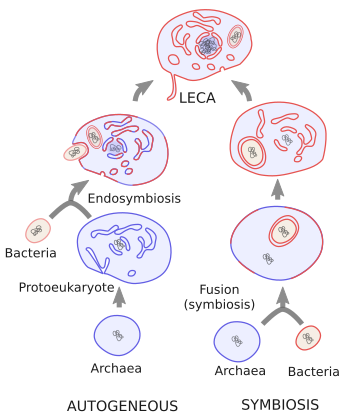Prokaryote were the first cells to appear on Earth, which happened about 3500x106 years ago. Prokaryote means before the nucleus, that is, they do not have DNA enclosed by an inner membrane. Prokaryotes were thought to be the only cell type during the first 1500 - 2000x106 year of the early Earth. Two main groups of prokaryotes are known: bacteria and archaea.
The eukaryote cell is regarded as an evolutionary transition. It was something new, with novel features . The eukaryote cells reached a highly morphological complexity level, integrate whole genomes, developed the sexual reproduction, and led to multicellular organisms.
1. When?
Eukaryotic cells appeared 1500-2000x106 years ago. It means that the process of eukaryogenesis should have being started much earlier.
2. From who?
It is not known how did eukaryotes emerge, but it should have happened as a result of the collaboration between the two prokaryotic cell types present at that time: archaea and bacteria. Eukaryotes are thought to be monophyletic, which means that all of them, including plants, animals, fungi, algae, and unicellular eukaryotes, descended from a common ancestor known as LECA (Last Eukaryotic Common Ancestor). So, with the evidences we have today, the eukaryote cell was "invented" only once during evolution.
There is no doubt that LECA evolved from prokaryotes, but from which one, bacteria or archaea? Choosing one of them is not easy (Figure 1). Current eukaryotes are like chimeras because genes from both types of prokaryotes coexist in the eukaryotic nucleus. For example, genes involved in DNA processing, including replication, transcription and translation are more similar to those of archaea, while those genes in charge of the metabolism are more similar to the genes of bacteria. However, not all genes follow these rules.
Recent evidences from genome phylogenetic studies place the origin of eukaryotes closer to archaea than to bacteria (Figure 1).

3. How? Eukaryogenesis
There is a key event during the emergence of LECA: what was the impact of the endosymbiosis of the mitochondrial ancestor? There are many theories about how the evolutionary process that gave rise to LECA happened. They can be summarized in two (Figure 2):

Eocyte or autogenous model . It suggests that an arcahea lineage progressively increased the cellular complexity to develop into the first eukaryotic common ancestor (FECA), and then into LECA. It means that a proto-eukaryote cell (FECA) was first developed, which emerged from the Asgard archaea lineage. These cells independently acquired most of the cell complexities found in the eukaryote cells, such as the endomembrane system and the cytoskeleton, but lack mitochondria. They also got the ability to do phagocytosis, that later allow them to acquire an ancestral alfa-proteobacterium.
Symbiotic model. This model proposes that the direct fusion of a archaea and a bacterium gave rise to the first eukaryotic cell. There was no proto-eukaryote intermediate stage between prokaryote and eukaryote. In the phylogenetic tree there would be two initial branches, archaea and bacteria, and then a third branch, the eukaryote. There are current examples of bacteria cells with prokaryote cell inside. The fusion of the two cell triggered the increase in cell complexity, and the bacteria became the mitochondria. In this new cells, archaea rules the DNA processing and bacterium the metabolism and membranes.
4. Endomembranes
One feature of eukaryotes, different from prokaryotes, is a rich and complex endomembrane system. The evolutionary origin of this system is still unknown. All the inner membrane-bound compartments may have been formed from archaea plasma membrane invaginations that were later detached. Thus, the interior of the endoplasmic reticulum or the Golgi apparatus is actually extracellular space. However, how the archaea lipids (isoprenoid fatty acid chains and ether bonds) were replaced by the bacteria lipids (no isoprenoids and with ester bonds) remains to be revealed.
-
Bibliografía ↷
-
Bibliografía
Archivald, JM. 2015. Endosymbiosis and eukaryotic cell evolution. Current biology. 25: R911-R921.
Dey G, Thattai M, Baum B. 2016. On the archaeal origins of eukaryotes and the challenges of inferring phenotype from genotype. Trends in cell biology. 26: 476-485
.
Gould SB, Garg SG, Martin WF. 2016. Bacterial vesicle secretion and the evolution- ary origin of the eukaryotic endomembrane system. Trends in microbiology. 24: 525–534.
Koonin, EV. 2010. The origin and early evolution of eukaryotes in the light of phylogenomics. Genome biology. 11: 209
.
López-García P, Moreira D. 2015. Open questions on the origin of eukaryotes. Trends in ecology and evolution. 30: 697-708
.
Martin WF, Neukirchen S, Zimorski V, Gould SB, Sousa FL. 2016. Energy for two: new archaeal lineages and the origin of mitochondria. Bioessays. 38: 850–856
.
-
 Origen of the cell
Origen of the cell 